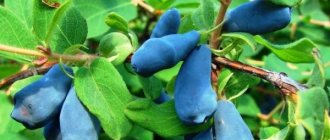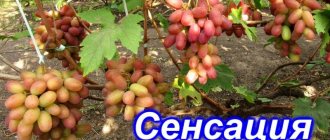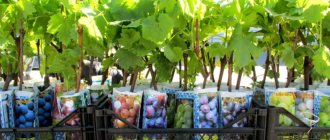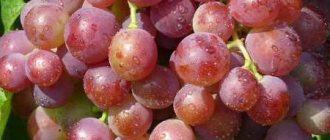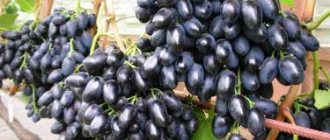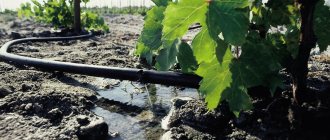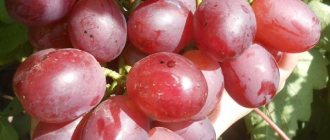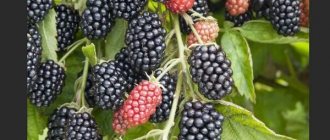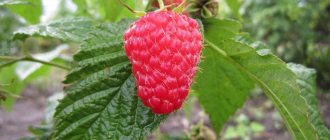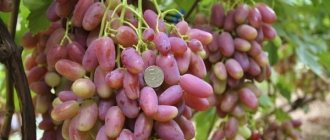A hybrid form of high-quality table grapes called Ataman was born in the early 2000s on the farm of the famous Russian folk breeder Viktor Krainov.
The variety was obtained as a result of crossing the Talisman variety, well-known and popular among amateur researchers, bred by the Novocherkassk Research Institute of Viticulture, with the Central Asian seedless grape Rizamat. A distinctive feature of both parent forms is their magnificent presentation, which they fully passed on to their offspring. But in addition to aesthetic qualities, Ataman inherited other useful properties from his parents: a pleasant harmonious taste of berries, high yield and good transportability of the collected bunches. At the same time, for the sake of objectivity, one cannot help but mention those shortcomings for which winegrowers sometimes criticize him. This is the hybrid's insufficient resistance to some diseases, a rather late harvest ripening period and a tendency for the berries to crack.
Despite such contradictions, the new product quickly gained popularity both among amateur winegrowers and among the community of farmers who saw in it prospects for commercial cultivation. Currently, although the excitement around the variety has subsided, its army of fans has remained stable and very significant for many years.
Description of the grape variety Ataman
The Ataman grape is famous for its large cylindrical-conical clusters , on which the fruits are located with medium density.
The weight of a bunch with proper care varies from 600 g to 1200 g .
The berries are very large (from 12 to 16 g) and have an elongated oval shape.
The fruits of "Ataman" are characterized by a red-violet hue, which in bright sunlight can change to dark purple.
The berries are protected by a thick skin, with a light coating of wax.
bush has many shoots and a fairly strong vine that can withstand heavy bunches of grapes.
The leaves of the grape are five-pointed and wrinkled, dark green in color, slightly pubescent below.
Correct fit
The degree of complexity of further grape care, as well as the quality and quantity of the future harvest, depend on the competence of planting work. Ataman grapes, like other varieties, love sunlight, so a planting site is chosen on the south side, well blown by winds. A southwestern slope is ideal. A humid environment can cause the proliferation of fungal infections in the soil where Ataman grows, so the movement of air in the atmosphere must be free.
Planting time is spring (from April to June) or autumn (from October until the onset of cold weather). In the second case, it is necessary to provide covering protection to the seedling. Sprinkle the planting hole with sawdust or pine needles. Mix the top layer of soil with ash, humus and superphosphate and form a mound. This mulching will help preserve the plant's heat balance.
Seedlings for planting are carefully selected and checked for damage and disease. The most suitable age for seedlings is 1 year, when their size reaches 10 cm and thickness – 12 mm. Before planting, they are soaked in clay. Extra eyes are removed from the shoots.
Grapes Ataman
Among the variety of varieties, Ataman definitely deserves attention. Agricultural cultivation technology is not so labor-intensive, and the yield is very high.
Description and characteristics of the variety
The Ataman variety is high-quality, durable and transportable. It belongs to the varieties of medium ripening period.
The berries are large, dense, covered with a characteristic coating. The hands are not tightly located, which allows it to be transported with virtually no damage. The color of the berries changes as they ripen, from pinkish-red to purple. The taste is sweet, but not cloying.
The leaf is large, five-lobed, and has a rich green color. The shoots are powerful and prone to intensive growth.
For reference! The grapes of this variety were bred by amateur breeder Krainov. The plant inherited from donor varieties the large size of berries and clusters and attractive coloring.
Advantages and disadvantages
This variety has many advantages. It is thanks to them that it has found wide application in agriculture.
- high productivity;
- disease resistance;
- keeping quality and transportability of berries;
- frost resistance.
There are not many disadvantages to this variety. The disadvantages include the high probability of cracking of berries during sudden changes in climatic conditions. Also, the disadvantages include the poor resistance of the variety to damage by gray mold, which is why there is a need for constant treatment with chemicals.
Scope of application
This variety can be classified as a table variety. The berries are unsuitable for making wine and juice. It is also impossible to use them for drying.
As a rule, on a production scale, the Ataman variety is grown for fresh sale.
Description of the advantages and disadvantages of the variety
Advantages of the Ataman variety:
- large fruits;
- abundant harvests;
- good transportability;
- excellent presentation;
- absence of wasps
Disadvantages of the Ataman variety:
- average resistance to diseases;
- the need for shelter for the winter;
- tendency to overload; rationing is mandatory.
The main advantage of the vine is its productivity. With good care, you can count on high performance. The vine can withstand the vagaries of the weather and bears fruit consistently even in cold summers. The berries are well stored and are not spoiled by wasps. The bush rarely gets sick and is affected by pests.
Mature bushes do not degenerate, berries do not pea, even with a large amount of harvest.
• low winter hardiness;
• need for crop rationing;
• tendency to overload.
The vine can withstand temperatures as low as -24°C, so in some regions it requires good shelter for the winter. Without this, the root system suffers from frost and takes a long time to recover.
Growing areas and features
The Ataman variety is heat-loving. It can withstand winter frosts only if there is shelter.
The southern regions of Russia are the most favorable for cultivation. You can also cultivate this crop in the middle zone with a temperate climate.
Important! This variety is not suitable for areas with cold climates and long winters. Even having achieved growth and flowering, it is unlikely that it will be possible to wait for the fruits to ripen.
Landing Features
Grapes are a demanding crop. It is very important to observe the timing of planting plants in the ground, as well as to provide the seedlings with the necessary care for full growth.
Time for planting in the ground
The best time to plant grapes is spring. In the southern regions, work can begin as early as the end of March. In temperate climates, the planting time is slightly different; the best time is early April - mid-May.
Attention! Late planting shortens the growing season of the plant and entails poor survival rate of seedlings.
The autumn period is also suitable for planting seedlings. For the southern regions this is the period from late October to mid-November. In the middle zone, it is better to start planting earlier; you can start as early as the beginning of October.
The advantages of autumn planting include an increase in the growing season, since seedlings will begin to develop earlier in the spring. The main condition for planting in the fall is high-quality shelter for the seedlings for the winter.
Characteristics
The Ataman variety has gained popularity among gardeners due to its high yield, which is maintained even in unfavorable weather conditions.
Productivity
The average weight of a bunch is 800 grams. Some specimens reach 1200 grams.
When it ripens
It takes about 130 days to mature. Therefore, the technical maturity of the fruit occurs around mid-September.
Frost resistance
Withstands cold temperatures down to -24 °C. Therefore, in regions with harsh winters it requires shelter.
Disease resistance
It has average resistance to fungal diseases. On a five-point scale, it resists oidium and mildew by 3 points.
Advantages of the hybrid form
This is the largest-fruited form with an impressive, attractive appearance. Thanks to this, it is famous for its high commercial properties and transportability.
Common diseases and pests
The plant is most affected by:
- Oidium. The disease affects the ripening of shoots, which can cause the death of the entire bush. It appears as a whitish coating on the leaves.
- Mildew. Characterized by oily yellow spots covering the foliage.
Pests:
- Compared to other varieties, Ataman is very rarely affected by wasps.
- Leaf beetle. Destroys young shoots and leaves and lays eggs on them. The larvae also eat leaves.
- Grape moth. A miniature red butterfly lays eggs twice a season. As a result, many caterpillars appear that destroy the foliage. Because of this, it dries out, which affects the abundance of the harvest.
- Grape mite. It overwinters in grape buds and damages them.
Characteristics of the variety
The grapes originated from crossing the Rizamat and Talisman varieties by amateur breeder V.N. Krainov in Novocherkassk. The first rewarded him with fruits of enormous size and abundant harvests, and the second - with durability and speed of ripening.
Advantages of Ataman grapes over other varieties:
- the largest fruit among existing species;
- ease of transportation (does not crumble or wrinkle);
- commercial attractiveness;
- resistance to wasps, in comparison with others;
- fruiting even in unfavorable conditions.
The grapes have a small number of disadvantages, among which the overload of bushes due to the abundance and size of the bunches stands out. A noticeable disadvantage is the average resistance to diseases and frost. A new grape variety, Ataman Pavlyuk, appeared recently through hybridization by breeder V. U. Kapelyushny. The Talisman and Osenniy Cherny varieties took part in the breeding.
The self-root growing system produces vigorous plants with well-ripening shoots. The plant is represented by a bisexual flower, a light brown vine, and green, heavily dissected, three-lobed leaves.
The grapes are distinguished by massive clusters reaching 800 g, and with proper care up to 1.2 kg. They reach 20-30 cm in length and 12-15 cm in width.
A special feature of the variety is its fleshy berries, the size of which ranges from large to very large. They are pinkish-red, red-violet, and with sufficient sunlight they take on a dark purple hue.
The shape is oval, with slight elongation. Inside the berry contains aromatic, thick pulp. The harmony of taste is diluted with slight sourness, which adds sophistication. Sugar content is 16-20 g/100 cm3, and the acidity level does not exceed 6-8 g/dm3. The fruit has a moderately dense, edible peel and 2-3 seeds.
The hybrid grape Ataman Pavlyuk is famous for its berries of impeccable quality, like its predecessor. All varieties are used to decorate the table. They are not suitable as raw materials for raisins and wine. Beneficial for business due to its resistance to transportation conditions.
History of selection
The author of the hybrid variety “Ataman” is considered to be the Russian amateur breeder V.N. Krainov, who obtained it by crossing the varieties “Talisman” and “Rizamat”. From the first, the new plant received high resistance to pests and cold, and from the second, “Ataman” received bisexual flowers, which provide a consistently abundant harvest. Both parent forms are characterized by excellent taste and a pleasant grape aroma, respectively, and the new plant has the same characteristics.
The hybrid was bred in a temperate continental climate, with hot and dry summers lasting about 175 days. For this reason, it is advisable to plant the variety in regions with relatively mild winters, where the temperature rarely drops below –15…–20°C. The ripening period of the variety is 130–145 days, and on average the grapes are harvested in early or mid-September.
Selection
“Ataman Pavlyuk” is a hybrid form. It was bred using pollen from the “Autumn Black” variety, which was applied to the flowers of the “Talisman” variety.
The grapes were developed as part of amateur research and were initially intended exclusively for personal cultivation by winegrower V. U. Kapelyushny.
Later, the variety was put up for sale as seedlings and quickly became widespread.
This is one of the youngest hybrid varieties. Among the new hybrids, one can also note the variety Valery Voevoda and Korolek.
Grapes Ataman Pavlyuk
There is another hybrid form of grape with a similar name, but with slightly different characteristics. Judging by the description of the Ataman Pavlyuk grape variety, they have a family relationship with the Ataman grape through one of the parents, and from the photo it is clear that the berries are somewhat similar to each other.
Description and characteristics of berries
The Ataman Pavlyuk grape was bred by amateur breeder V.U. Drop by crossing the varieties Talisman and Autumn Black. It also belongs to the mid-late grape varieties, since it usually ripens during September, depending on the growing area.
Decorative poppy: varieties with photos, planting and care
The growth vigor of the bushes is above average; the vine ripens quite early along the entire length of the growth. Each shoot can bear from two to four inflorescences, so the grapes require rationing. Usually one, maximum two inflorescences are left per shoot.
Resistance to diseases can be called good. Of course, you can’t do without fungicide treatments, but you can get healthy bushes by performing only a few preventative sprays per season.
The yield is good, the bush can pull a very heavy load. The video below clearly shows what this grape variety is capable of.
The bunches can reach significant sizes, up to 2 kg, with an average weight of 700-900 grams. The berries are dark purple, almost black in color. The shape is oval, the size of the berries is large, on average the weight of one berry is 10-12 grams. Pea peas are usually not observed. The taste is very pleasant, sweet with harmonious sourness. The pulp is dense and fleshy.
In suitable conditions, bunches of grapes can easily be stored until the New Year, and some even until spring.
Description
Valiant is a tall plant with a rich crown. With beautiful and tasty clusters of high sugar content and medium acidity.
Bush
The grapevine has the following characteristics:
- tall fluffy bushes;
- vine - about 10 cm;
- weak pubescence of sprouts;
- bush color – green;
- petiole notch – open;
- early maturation;
- high winter hardiness;
- good return. 3-4 bunches per shoot.
The structure of the vine resembles a tree (bush). It has a trunk, a root, a crown.
bunches
The culture produces inflorescences of both sexes. The clusters resemble a cone, weighing up to 100 grams. The fruits are black with a purple tint.
Berries
Small berries have the following properties:
- oval shape without dents;
- weight of one berry – 1.5-3 g;
- close arrangement of fruits relative to each other;
- sugar content - about 20%.
The pleasant aromatic taste with a hint of strawberry and pineapple notes attracts not only humans, but also birds and wasps.
Varieties - pollinators
According to reviews from gardeners, it cannot be said that Valiant really needs pollinating grapes. But it won’t be harmful to plant such plants. This will increase the growth rate.
Arcadia is considered more suitable - a popular high-yielding variety that produces large berries with a nutmeg taste. Suitable varieties are Rusbol, grown specifically for the northern regions, and Radiant Kishmish, with large sweet fruits that taste like nutmeg.
Ripening time
Valiant grapes are a mid-season variety. The vital activity of the plant begins with budding and lasts 128-140 days, until harvesting. But it all depends on the landing area. Grape ripening begins at the end of August (beginning of September).
Productivity and fruit size
Valiant belongs to the category of high-yielding varieties. From 2.5-4 sq. meters, at least 10-12 kg are collected every year, and sometimes more. A good harvest is obtained with proper care and appropriate weather conditions.
Description and characteristics of grape variety Jubilee Novocherkassk
Read
Where are the berries used?
First of all, the delicious, fragrant berries are eaten. They are used to prepare juices, jellies, compotes, and make jam. Dry wines made from grapes are in demand. The taste of dark ruby grape drinks is pleasant. In addition, the hybrid is used as a component of blended wines.
Due to the characteristics of the bush and high winter hardiness, Valiant is used for landscaping and decorating architectural structures, arches, canopies and as elements of landscape design.
Pruning and care
Bushes of great growth vigor. The leaves are five-lobed, large, with slight pubescence on the lower part. Flowers are bisexual. The cuttings quickly take root and grow together with the rootstocks when propagated by grafting. Some gardeners plant Ataman near the gazebo. It is recommended to do pruning by 8-10 buds, but different sources advise leaving the number of eyes different: from 30-40 to 55-60 pieces per plant. An important note: pruning is recommended to be done in the fall, before laying the vines on the ground for shelter for the winter. In summer, you need to make sure that there are no thickening shoots and stepsons on the bush.
This hybrid form is very afraid of overload, not only because of the high yield, but also because of the medium-late fruiting. If the bunches are not rationed, then ripening is delayed, the vine may not have time to ripen and the bush will face the winter unprepared. In this case, the plant may “skip” next year by taking a time out to recuperate. It is necessary to cover the Ataman, the frost resistance of the variety is only -23ºС. It is better to use slate, wooden panels and similar materials as covering materials. According to reviews, the form does not tolerate wintering under shelter from the ground.
Ataman's disadvantages include his fairly noticeable susceptibility to oidium. As is known, this fungal disease delays the ripening of vines, which can become critical for the described variety. The form also manages to “catch” gray rot. Therefore, you need to be careful when spraying with fungicides and not skip them. Treatments are best carried out preventively, before the disease appears, rather than eradicating, after signs of the disease have already appeared.
With a sharp change in soil humidity, when prolonged heat is replaced by heavy rains, the berries can burst, and in an unripe state. If the density of the bunches is quite high, this can create significant problems, especially if the berries rot. Therefore, Ataman is sensitive to the watering regime. Many gardeners find a way out of the situation by frequently moistening the soil under the bush. It is convenient to solve this issue by installing drip irrigation.
In the steppe climatic conditions of southern Ukraine, the variety faces another problem - the berries can bake in the sun. To avoid this, you do not need to pick off all the leaves shading the bunch.
About some mistakes when growing in the video:
Ataman
| Seedling: | 50 UAH | Add to cart | |
| Remaining stock: 25 pcs. | |||
| Cutting: | 20 UAH | Add to cart | |
| Remaining stock 29 pcs. | |||
| Ripening period | medium-late (130-145 days); |
| Flower functionality | bisexual; |
| Bunch weight | 600-800 g, individual up to 1.2 kg; |
| Berry weight | 15-20 g (38 x 24 mm); |
| Taste | harmonious; |
| Bushes | vigorous; |
| Frost resistance | -23°C; |
| Disease resistance | average. |
The Ataman grape variety, bred by the famous breeder V. N. Krainov, is one of the good grape hybrids. The main advantage of the variety is its high yield, and the grapes received this quality from one of the “parents” - the Talisman variety. And the second “parent” is Rizamat, who gave Ataman the beautiful color of ripe berries.
Description of the variety
The oblong ripe grape fruits have an impressive mass - approximately 20 g. Each berry contains up to 3 small seeds. Ripening berries have an amazing color - pink with a red tint, often the color can change to purple. The pulp is fleshy, very juicy. The peel of the fruit is strong, so ripe bunches tolerate transportation well. Despite the high yield, the berries do not have peas.
The clusters have an attractive decorative appearance; the weight of one cluster can range from 0.5 to 1.5 kg. Moreover, the large weight of the bunches is achieved thanks to good care of the grape bushes. Brushes can have different shapes:
- cylindrical;
- conical;
- and may also have characteristic “wings”.
The taste of ripened fruits is wonderful - their sweetness, combined with light sourness, is perfectly refreshing. The amount of sugar in fruits is average - about 18%, and acids in them - up to 8 g/dm3.
The crop usually matures within 4.5–5 months from the time the leaves appear. In the southern regions of the country, for which this variety was bred, the clusters usually ripen in the second ten days of September.
The bushes are vigorous. Each leaf consists of five lobes, the foliage is large, slightly pubescent on the underside. Both male and female flowers bloom on the bushes. The cuttings take root excellently and quickly. When propagated by grafting, the cuttings quickly grow together with the rootstock. A great place for these grapes instead of trellises can be summer gazebos in the garden.
Nuances of caring for this grape variety
It is better to trim the shoots, leaving 9–10 buds. And on the bushes you can leave from 35 to 60 eyes. Grape bushes should be pruned in the fall, after all the foliage has fallen. It is best to prune immediately before covering the grapes for the winter.
In the summer, weak shoots and shoots are usually removed to prevent the bushes from thickening.
This hybrid is highly productive, however, the number of clusters on the shoots must be normalized so as not to overload the vines. If this is not done, then the vines may not ripen during the season, and the bushes may face frosts unprepared. At the same time, next season the grapes can rest, ovaries will not form on them, and there will simply be no harvest.
For the winter, this variety should definitely be covered, because this variety has low frost resistance: it can withstand cold temperatures down to -20, 23 degrees Celsius. Wooden panels, slate and other similar materials are usually used as covering materials for the Ataman variety. But it is not recommended to cover these bushes with earth - this variety does not tolerate wintering under such covering material.
The main disadvantage of the Ataman variety is its strong susceptibility to oidium. This disease affects the ripening of shoots, and this can be disastrous for the bush as a whole. Also, this variety is not resistant to gray rot. Therefore, you should regularly spray the grape vines with copper sulfate and fungicidal preparations throughout the season. We must remember that it is easier to treat bushes prophylactically than to later fight the diseases themselves, when their signs have already appeared on the plants.
If the heat suddenly gives way to a period of rain, such a difference in the amount of moisture in the soil can cause even unripe berries to burst. Since the clusters of the Ataman variety are very dense, bursting berries can cause the majority of fruits in the bunches to rot. Therefore, it is necessary to regularly water the soil under the bushes of this vineyard. It is best to water the soil under the vines by drip.
In steppe regions, the sun can burn the bunches of these grapes strongly. Therefore, you should not tear off the foliage that covers the brushes from the sun's rays.
Reviews of Ataman grapes
Many gardeners are dissatisfied with the amount of harvest collected from the Ataman grape vines, although it is believed that these grapes bear fruit well.
Gardeners in the southern part of our country prefer to grow this variety for fresh consumption. Due to its relatively late ripening, there is no need to grow it for industrial purposes.
Conclusion
This variety was zoned for the southern regions of Russia and Ukraine. The variety is quite late in ripening, and not everyone likes its taste, because it is quite sour. Due to the average frost resistance, the Ataman variety is better not to plant it even in central Russia.
How to plant correctly
To obtain a bountiful harvest, it is necessary to plant seedlings correctly.
What to pay attention to
When planting Ataman grapes, attention is paid to the terrain. The area should be bright with constant access to sunlight.
Tall crops should not grow nearby, which will subsequently take elements and water necessary for the development of grapes from the ground, thereby reducing yields.
Selection of seedlings
When purchasing, pay attention to the appearance. There should be no visible damage or signs of disease. The root system needs to be healthy and strong. If the roots are dried, then you should not purchase this specimen. Saplings are chosen as annuals.
Planting step by step
To avoid mistakes, follow simple rules:
- Do not plant in acidic or alkaline soil. Water should not stagnate, so clayey terrain is not suitable. Excess moisture causes cracking of the berries. Also, the plant does not like soil that is too sandy, where water quickly drains away.
- The hole is prepared in advance. Fertilize and leave for at least two weeks.
- Before planting, the root system is placed in water for a couple of hours.
- After planting, the soil is trampled down and the surface is mulched with available material. You can use foliage, dry grass, crushed stone.
A support is installed next to the bush that will support the vine.
Landing rules
In terms of planting and further care, the Ataman grapes are not much different from other varieties of medium ripening, however, in order to obtain an abundant and high-quality fruit harvest, it is still worth paying attention to some of the nuances of its cultivation.
How to choose quality seedlings when purchasing
Both annual lignified seedlings and still green specimens found during the growing season are perfect for planting on the site. If there is no ready-made planting material, it is advisable to purchase it from a trusted nursery, whose reputation has already been confirmed in practice. When examining the selected specimen, pay attention to all its parts: neither the leaves, nor the vine, nor the roots should have any damage or signs of disease. It is desirable that the root system of the plant consist of at least three developed roots, 10 cm each.
In addition, the rhizome must be dry, and this also applies to seedlings with an open root system. The shoot of the selected specimen (preferably it should be at least 20 cm in length) should have 4–5 healthy buds, and the vine of the plant should not have any cracks or growths. When buying green seedlings, you will have to pay more attention to the issue of their transportation, since they are more vulnerable and can break during transportation.
Where to plant on the site
A sunny area on the south side of the house is perfect for growing “Ataman” grapes, the main thing is that it is closed from cold winds and protected from possible stagnation of water. The last requirement is one of the most relevant, since the described variety is prone to fungal diseases, which develop best in a humid environment. Excessive accumulation of moisture can be prevented with the help of warm summer drafts, so if the selected area is located at a slight elevation and is slightly blown by a warm summer wind, there is nothing wrong with that.
As for the optimal soil composition, for chernozems and loams, a prerequisite for planting will be the organization of a drainage layer and the application of phosphate fertilizers for digging. In addition to them, you can use humus and mineral compounds with a high nitrogen content, which are added to the soil during autumn soil preparation.
Blue rooster and hen - a complete description of the Andalusian breed
How to plant
Preparations for spring planting of purchased grape seedlings can begin in the fall, ridding the selected area of debris and weeds and digging. If we are talking about planting lignified shoots, then the best time to perform the procedure is considered to be mid-April, while green seedlings can be replanted only at the end of May, after the street temperature has stabilized. A few weeks before planting the grapes, you need to prepare the appropriate hole for it. To do this, dig up the soil on the site to a depth of 60–70 cm, and then prepare the planting pit itself.
Its depth can reach 70 cm, and its width should exceed the diameter of the plant’s rhizome by about 10–20 cm. In this case, it is necessary to take into account the available amount of soil mixture: when preparing the nutrient substrate separately, the hole can be larger (about 80 cm). If you decide to plant several plants at once, then it is worth considering the optimal layout for their placement, which provides for a three-meter free space between adjacent plants and a two-meter distance to the adjacent row.
Scheme for preparing a hole for planting grape seedlings The planting process is simple and is based on the following steps:
- Place expanded clay, broken brick or any other drainage material at the bottom of the hole in a layer of 20–25 cm and fill it with a little nutrient soil.
- Place the purchased seedling in the planting hole - it is possible so that the upper roots are in the upper soil layer (the plant should be deepened no more than 15-30 cm).
- Cover the plant with the remaining soil and cut off the upper part of the seedling: if it has 2 shoots, then each of them needs to be shortened to the second bud. Up to 4 eyes are left on one shoot.
- Water the seedling and place a small mound of soil 15–20 cm high around the root collar.
Official information
The hybrid form was created by national breeder V. U. Kapelyushny (Rostov region, Russia).
The botanist from the varieties “Talisman” x “Autumn Black” has long been known for its excellent hybrid forms.
The grape form is already more than ten years old . It ceased to be a novelty and did not gain much popularity. However, reviews from those who have been growing the “ataman” for all these years say that the form is worthy, and they are not going to part with it.
Description of the form
Original inflorescences of Ataman Pavlyuk grapes.
- The variety has very high growth vigor , shoots ripen well along their entire length. The rooting rate of cuttings is very high.
- The vines are pruned to 8–10 buds. The load on the bush is allowed up to 45 eyes.
- Winegrowers note that fruiting on their own roots is good, but on a grafted crop the yield and quality increase several times . Cobber 5 BB, SO-4 rootstocks .
Bunch and berry
The bunches are mostly semi-loose, weighing up to 1 kg.
- Having reached full maturity, the bunch has a length of up to 40 cm . If the author, when characterizing the form, describes a weight of 700–900 g, then reviews indicate that bunches weighing up to 1500 g are not at all uncommon. Some recorded weight in 2000.
- In addition to excellent weight, the bunches have a beautiful appearance . Cone-cylindrical in shape, aligned, absolutely all have 1-2 wings, which make the bunch expanded in the upper part. The bunch is loose, but so much so that its appearance is impeccable. The berries do not interfere with each other and at the same time do not leave any empty space.
- Due to the long, up to 12 cm, and strong comb, the variety holds well on the vines, and then it helps it to be stored well.
- The bunch, despite its weight, is perfectly held on the vines.
- The berry, when fully ripe, has a rich black color and an excellent waxy coating . The shape of the berry is oval and large. Average weight up to 15 g. No peas were detected even once.
- The pleasant, harmonious taste of the berry puts it among the leaders in tasting assessments . When harvested at the optimal time, there is a good accumulation of sugar. Many winegrowers believe that this variety is more to the taste of lovers of sweet varieties.
- It is also characteristic that the accumulation of sugars occurs very late and this quality makes it possible to “snatch” the bunches from wasps . Attacks are almost never observed.
- The pulp is juicy . The seeds are dark, 1–2, medium in size. The skin is of medium thickness, good chewing.
The berry develops a harmonious taste closer to October and does not become watery even after prolonged downpours.
Productivity
Winegrowers highly value this variety for its productivity. Each shoot bears 2–3 clusters, and each cluster weighs 1–1.2 kg.
By providing a feeding area of three meters, the load on the bush is such that it is not difficult to obtain a yield of up to 40 kg.
Seaweed: benefits and harms, composition, recipes
Ripening time
Medium-late ripening variety. If in more southern latitudes it fully gains color and taste by the beginning of September, then to the north the clusters are ready for consumption only by the end of this month.
The brushes are almost ripe, try them in a week and remove them for storage.
Some winegrowers were initially frightened by the fact that by the end of September the grapes did not have any special charms in taste, and significant sourness was felt. However, its ability to quickly accumulate sugar and aromatic components delights even experienced winegrowers.
Huge clusters of grapes can hang on the vines without damaging their presentation . The vineyard turns into a wonderful showpiece.
Those who are in no hurry to sell surplus produce store the harvest on the vines until the first frost, and then carefully send it for storage.
Use in the kitchen
Having stored the bunches, you can not doubt for a second that these grapes will decorate your New Year's table.
Gardeners unanimously claim that Ataman Pavlyuk lies until it’s over.
The variety has excellent keeping quality and an absolutely pristine appearance . There is no data on how long these grapes can be stored after the New Year holidays, since they are simply eaten.
Compared to the mature variety "Moldova", "Ataman Pavlyuk" is stored better and has a higher accumulation of sugars.
Frost resistance
Looking at the reviews of winegrowers, you can notice that there is not a single review that the grapes do not tolerate frost well.
Officially, stability is stated at a level of - 25 ᵒC , but reviews also speak of lower temperatures.
Looking at such indicators, winegrowers, especially in the southern regions, are filling larger and larger areas with plantings of this form, since additional efforts are not required to carry out sheltering work for the winter.
Disease resistance
The form is resistant to major grape diseases.
Winegrowers are unanimous in the opinion that this hybrid form has absorbed all the best from the mother varieties. Disease resistance is at a fairly high level , but this does not mean at all that the grape form should be left untreated.
Unfortunately, today there is not a single variety that can fully ripen without preventive spraying.
This variety is resistant to mildew, oidium and gray grape rot . Regarding oidium, reviews indicate that even when grape bushes of other varieties are affected by this fungus, our variety remains clean.
Diseases and pests
“Ataman” is moderately resistant to fungal diseases, so it is necessary to constantly check the bush and begin treatment at the first signs of fungus.
Oidium manifests itself as a white coating on the foliage . To combat infection, chemical methods are used: treatment with Vectra, foundationazole. With biological methods, the plant is treated with aqueous infusions of hay dust and a suspension of sulfur.
Mildew is also a very dangerous fungal disease of the vineyard. If the disease has affected the bush, then yellow oily spots appear on the leaves.
The fungus is removed using preparations that contain copper.
As for other diseases to which many grape varieties are susceptible, you can familiarize yourself with them in special materials on our website. Read about bacterial cancer and chlorosis, anthracnose and rot, bacteriosis and rubella. Knowing the signs of diseases and having an idea of prevention, you will be able to reliably protect your plants.
Wasps are not the most dangerous pests for grapes. Basically, they spoil the appearance of the bunches more with eaten berries.
For a table grape variety, even a few spoiled berries in a bunch are a serious problem, because the presentation has already been lost. "Ataman" suffers less from wasps than many other grape varieties, thanks to its dense skin that protects the pulp of the berries.
If, nevertheless, insects have reached your crop, then you first need to look for a wasp nest nearby and remove it .
Near the vineyard you can place special traps for wasps .
If there are few grapes, you can protect the bunches with special bags. Large plantations are sprayed with insecticides. Ripe grapes are thoroughly washed before use.
Grape flea beetle (leaf beetle) : loves to feed on young leaves and shoots. Lays eggs on them (up to 30 pieces in one pile). The larvae also chew leaves.
Due to the pest, the foliage can be seriously damaged, which will ultimately affect the yield. To prevent the pest, the grapes are sprayed with an insecticide as soon as the first buds bloom. This can be Karbofos or Fufanon.
Grape leaf miner . A small red butterfly can lay eggs twice during the season, from which a large number of caterpillars will emerge.
Caterpillars eat tunnels in the leaves in the form of light stripes. If you do not fight the pest in any way, many leaves will dry out and the harvest will be significantly reduced.
Grape leaves must be constantly inspected and if light streaks appear, Confidor must be applied immediately. To prevent the appearance of moths, dig up the soil for the winter and remove any remaining vegetation.
The grape leaf mite is a very dangerous pest. It waits out the winter in grape buds, damaging them. Weak shoots grow from injured buds.
Meanwhile, the mite moves onto the leaves and deforms them. The leaves die over time. The vineyard should be treated with acaricide: Apollo, Fufanon up to five times per season.
Reproduction
You can get new Ataman grape seedlings in two ways - cuttings and layering. Both methods are applicable, but cuttings are most often used.
The process of obtaining planting material consists of several stages:
- At the beginning of June, cuttings are cut from a young vine, leaving 2 leaves and 2 buds on each.
- Each cutting is wrapped in cloth and left overnight in a container of water.
- After treatment with a growth stimulator, planting is carried out in prepared nutrient soil.
- After abundant watering, a shelter is installed.
- During the rooting process, regular spraying is carried out to maintain humidity.
- After 3-4 weeks, the cover is removed and spraying is stopped.
- Rooted cuttings are left for storage in the basement until spring planting in the ground.
Planting material obtained by cuttings has all the characteristics of the mother plant.
Attention! Before planting the cuttings in the soil, remove the bottom leaf. The remaining top is cut in half.
Features of care
For full development and abundant fruiting, it is necessary to carry out a number of agrotechnical procedures. Each of the points is important and necessary.
Young seedlings especially need care
Watering
Young plantings need regular watering. Mature plants, thanks to their deep and powerful root system, can tolerate mild drought.
As a rule, vineyard irrigation is carried out in early spring, after flowering and before the berries begin to ripen.
Attention! If the autumn is dry, additional watering is carried out in early - mid-October.
Feeding
Both mineral and organic fertilizers should be applied regularly.
- In spring, mineral fertilizers containing nitrogen and phosphorus are applied.
- In the first half of summer they fertilize with nitrogen.
- In the second half - phosphorus-potassium supplements.
- In the fall, it is preferable to add organic matter, manure or compost.
